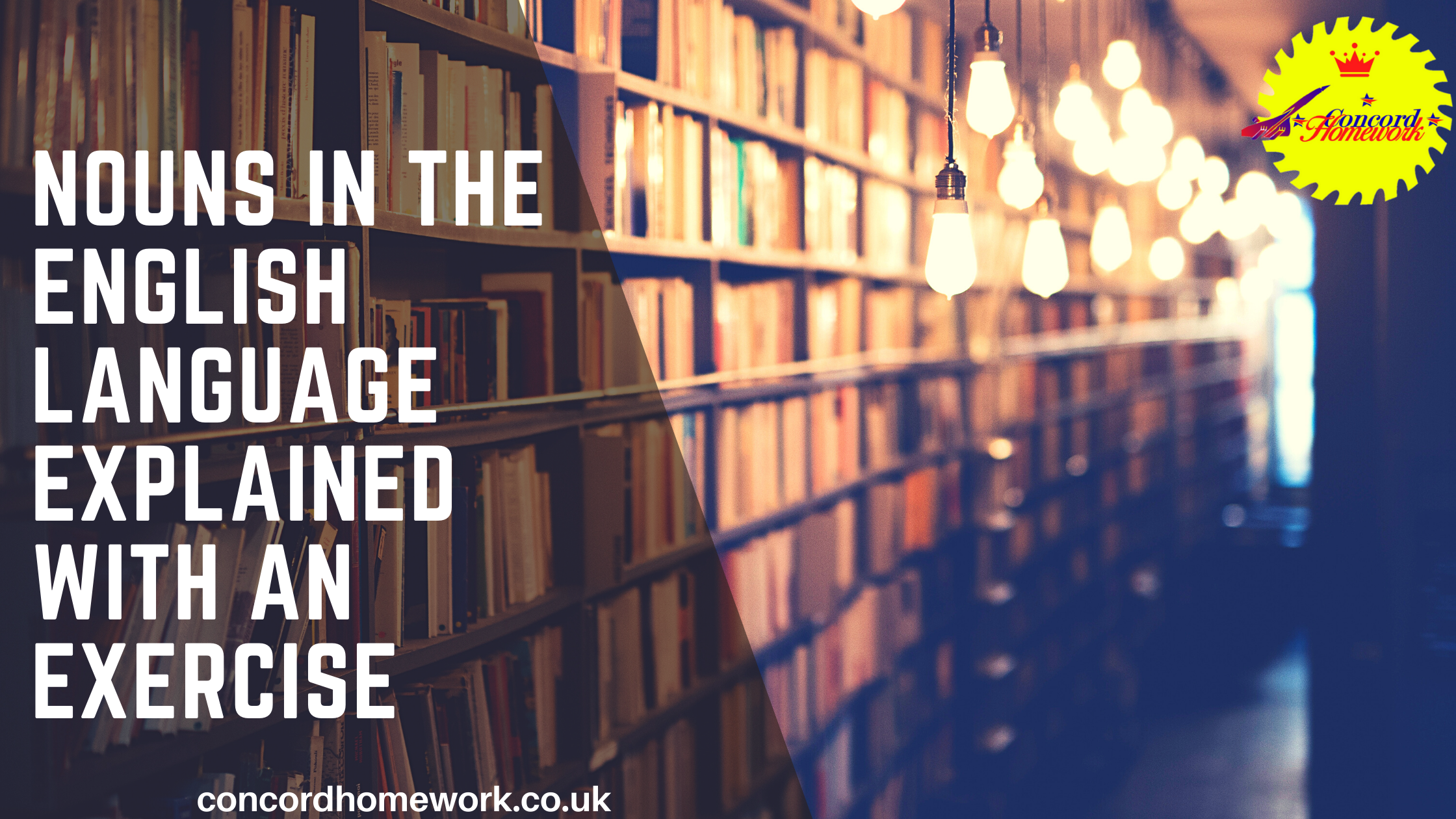Nouns in the English Language
Common Nouns
Nouns are divided into common nouns and proper nouns.
Common nouns are words for people, animals, places,
or things.
These are words for people. They are common nouns:
actor lawyer aunt judge baby man baker nurse cook police officer dentist singer doctor soldier giant teacher
These are words for animals. They are common nouns:
eagle zebra deer bird crocodile bear
These are words for places. They are common nouns:
airport market cave mountain playground farm restaurant
These are words for things. They are common nouns:
bag kite box ladder bread lamp
Proper Nouns
Proper nouns are names for particular people, places or
things. They always begin with a capital letter.
Here are some more names of people:
Ali Baba Florence Nightingale Derek Jeter Patrick Harry Potter
The names of countries and their people are also
proper nouns:
America Americans Korea Koreans Egypt Egyptians Malaysia Malaysians
The names of towns, cities, buildings and landmarks
are proper nouns:
the Great Wall of China Brooklyn Bridge the Statue of Liberty the Eiffel Tower Pike’s Peak Sydney Tokyo
The days of the week and months of the year are proper
nouns:
Sunday Monday Tuesday, January
February March
The names of mountains, seas, rivers and lakes are
proper nouns:
Lake Michigan the Alps the Himalayas the Dead Sea the Pacific Ocean
The names of festivals, some special events and holidays
are proper nouns, too:
Mother’s Day Memorial Day April Fool’s Day Labor Day Thanksgiving Day Independence Day
Singular Nouns
Nouns can be singular or plural. When you are talking
about one person, animal, place, or thing, use a singular
noun:
an airplane a letter a bicycle a map a boy a photograph
Plural Nouns
When you are talking about two or more people,
animals, places, or things, use plural nouns.
Most nouns are made plural by adding -s at the end:
bird birds/broom brooms/camel camels/desk desks/doll dolls/egg eggs
Some plural nouns end in -es:
beach beaches/branch branches/box boxes/bush bushes/dish dishes/dress dresses
Some plural nouns end in -ies:
baby babies/cherry cherries/diary diaries/dictionary dictionaries/fairy fairies/family families
What if there is a vowel before the y?
In that case, add -s to form the plural:
chimney chimneys/cowboy cowboys/day days/donkey donkeys/jersey jerseys/kidney kidneys/monkey monkeys
If a noun ends in -f, you often change f to v, and add -es:
Singular: calf Plural: calves/Singular: loaf Plural: loaves/Singular: elf Plural: elves/Singular: shelf Plural: shelves/ Singular: half Plural: halves/
Singular: thief Plural: thieves/ Singular: leaf Plural: leaves
/ Singular: wolf Plural: wolves
With some words that end in -fe, you change f to v, and add -s:
knife knives/life lives/wife wives
But you only add -s to giraffe to form the plural.
If a noun ends in -o, you just add -s to form the plural:
a hippo hippos/a video videos/a zoo zoos
But with some nouns that end in -o, you add -es to form
the plural:
a tomato tomatoes/a potato potatoes/a hero heroes
With some nouns that end in -o, you can add
either -s or -es to form the plural:
a mango mangoes mangos/a mosquito mosquitoes mosquitos
a zero zeroes zeros/a buffalo buffaloes buffalos
Some plural nouns don’t follow the -s rule. They don’t end in -s, -es, -ies or -ves. Instead, the word changes form:
child children/man men/ox oxen/tooth teeth/woman women/mouse mice
Note:
The plural of the mouse that you use with your computer is either mice or mouses.
Some plural nouns are the same as the singular noun:
bison bison/deer dee/sheep sheep/fish fish
Some plural nouns are the same as the singular noun:
bison bison/deer dee/sheep sheep/fish fish
Note:
You can use fishes as the plural of fish when you are talking about
different kinds of fish: all the fishes of the Pacific Ocean.
Some nouns are always plural:
pants/scissors/pajamas/sneakers/shorts/slippers/trousers/stockings/
sandals
Some nouns are always plural:
pants/scissors/pajamas/sneakers/shorts/slippers/trousers/stockings/
sandals
Collective Nouns
Collective nouns are words for groups of people,
animals or things.
These are nouns for groups of people:
an audience/ a gang/a band /a group/a choir/ a team/a class/ a family/ an orchestra
Here are more collective nouns that are used for groups
of people, animals or things.:
a bunch of keys/a class of pupils/a collection of books/a deck of cards
a fleet of ships/a flock of sheep/a gaggle of geese/a gang of robbers
a herd of cattle/a litter of cubs/a pod of whales/a pack of wolves
a pride of lions/a set of stamps/a swarm of bees/a troupe of actors
a school of fish
Here are more collective nouns that are used for groups
of people, animals or things:
a bunch of keys/a class of pupils/a collection of books/a deck of cards
a fleet of ships/a flock of sheep/a gaggle of geese/a gang of robbers
a herd of cattle/a litter of cubs/a pod of whales/a pack of wolves
a pride of lions/a set of stamps/a swarm of bees/a troupe of actors
a school of fish
Masculine and Feminine Nouns
Masculine nouns are words for men and boys, and
male animals.
Feminine nouns are words for women and girls, and
female animals:
boy girl/man woman/prince princess/steward stewardess/waiter waitress
king queen/rooster hen/lion lioness
Many nouns are used for both males and females. We call these nouns common-gender nouns:
accountants parents artists managers designers pupils engineers singers
lawyers teachers
Words for things that are neither male nor female are
called neuter nouns:
ball forest building gymnasium broom playground cake rock computer sky
card socks floor wind
“Thank you for taking the time to explore this topic with us! We hope you found the information helpful and insightful. Have any thoughts, questions, or additional examples to share? We’d love to hear from you in the comments below!
Don’t forget to spread the word by sharing this blog with your friends, family, and colleagues. Together, let’s continue to learn, grow, and connect with the world around us. Happy reading and sharing!”
Follow Me On TikTok:
Follow me!????????????????
Follow me on YouTube:
-

Watch the video, then answer the question. #learnenglish #quiz #english #shorts
-

Watch the video, then answer the question. #quiz #learnenglish #english #englishquizchannel #shorts
-

Watch and learn #learnenglish #English #shorts
-

Quiz time. Watch then answer the question. #quizchallenge #quiz #riddles #puzzle #shorts
-

Watch the video, then answer the question. #LearnEnglish #QuizTime #english #shorts
-

Quiz time. Watch then answer the question. #quiz #quizchallenge #learnenglish #shorts
-

Watch the video and answer the question. #quiz #learnenglish #english #quizchallenge #shorts
-

Quiz challenge. Watch then answer. #quiz #quizchallenge #learnenglish #shorts
-

Quiz time. Watch then answer the question. #quiz #quizchallenge #shorts
-

Watch the video, then answer the question. #learnenglish #quiz #english
-

Watch the video, then answer the question. #learnenglish #quiz #english #shorts
-

Quiz challenge. Watch then answer. #quiz #quizchallenge #learnenglish #shorts
Subscribe!????????????????
What topics/worksheets do you need? Let me know in the comments below!




















